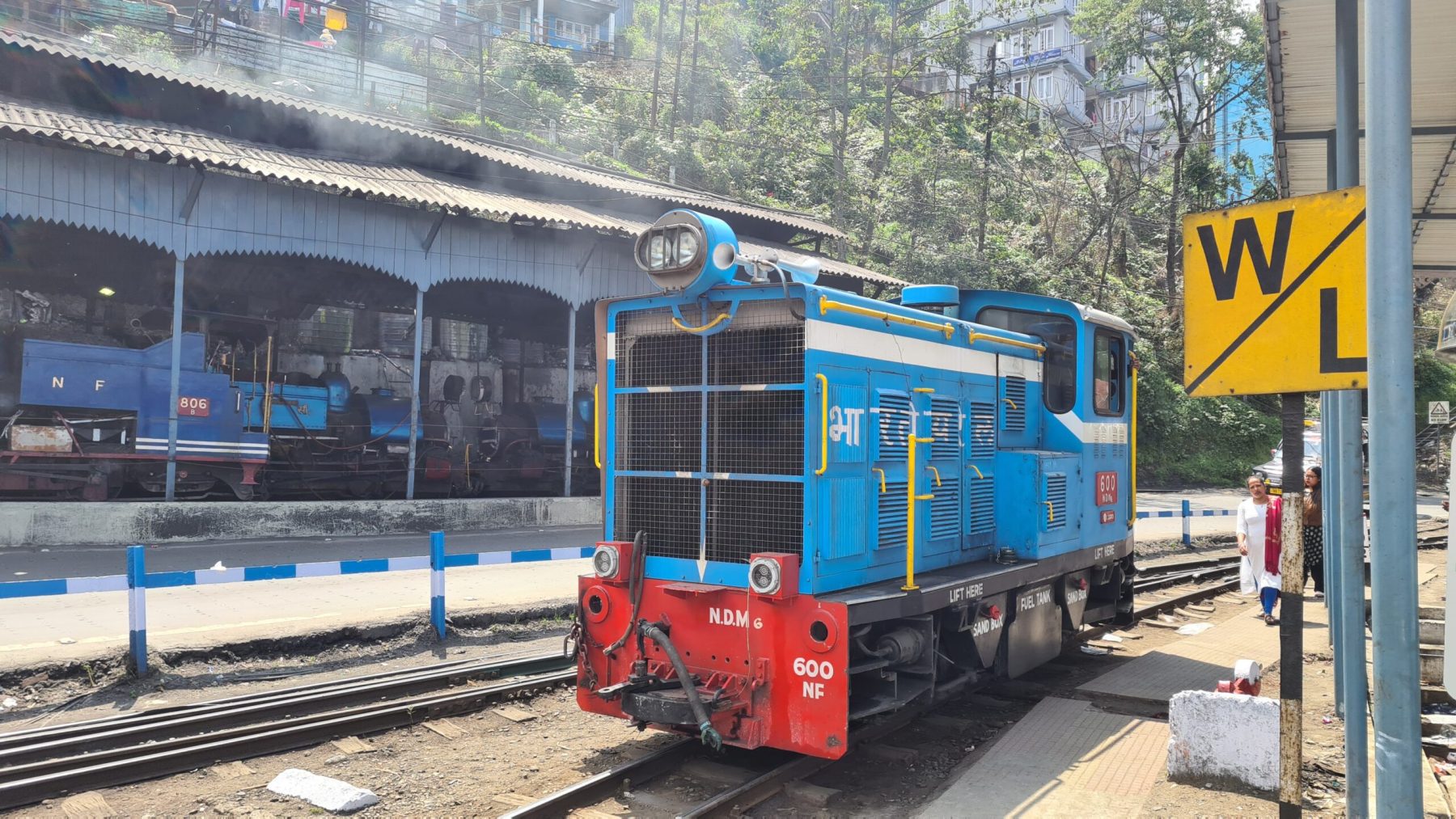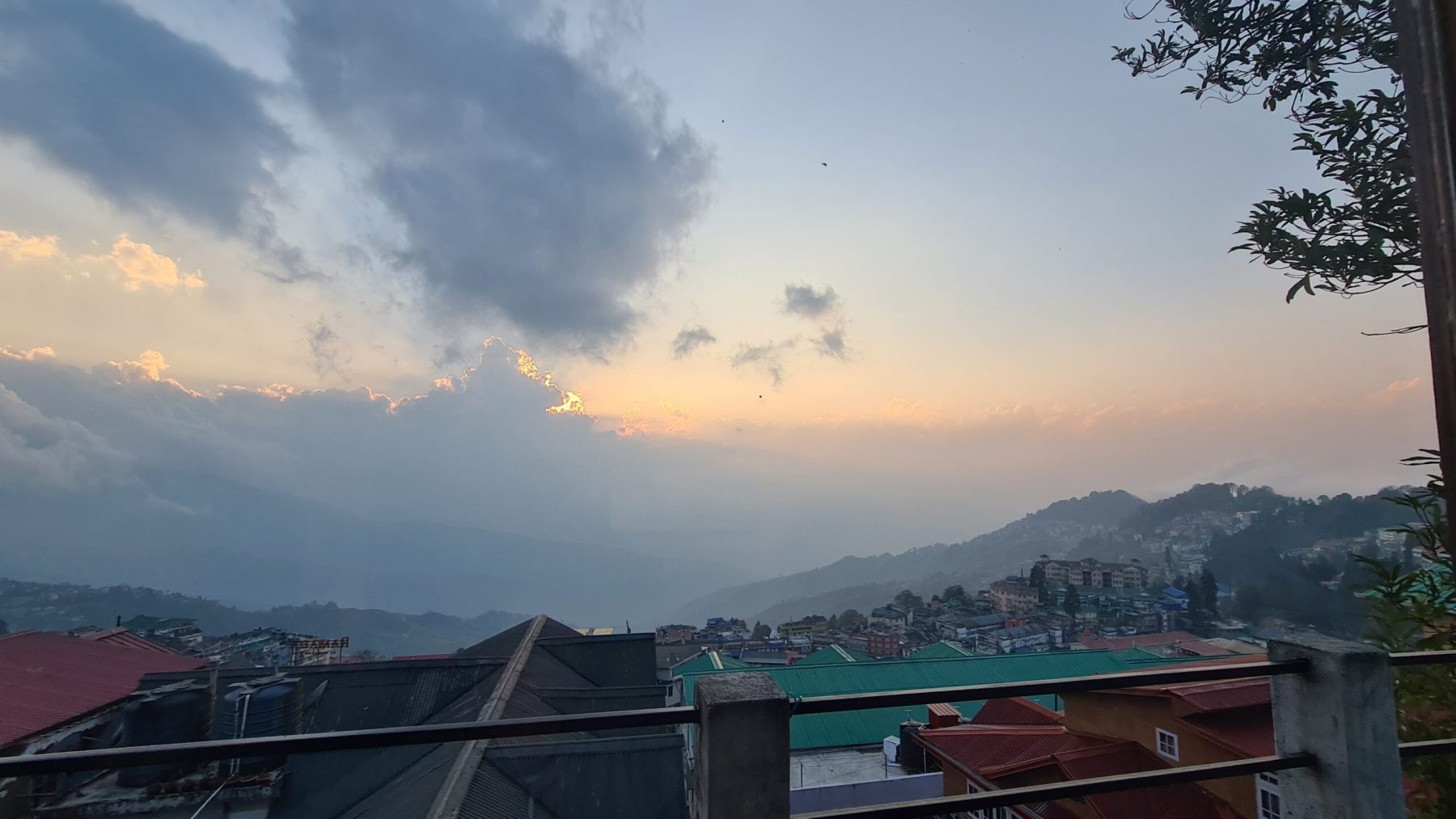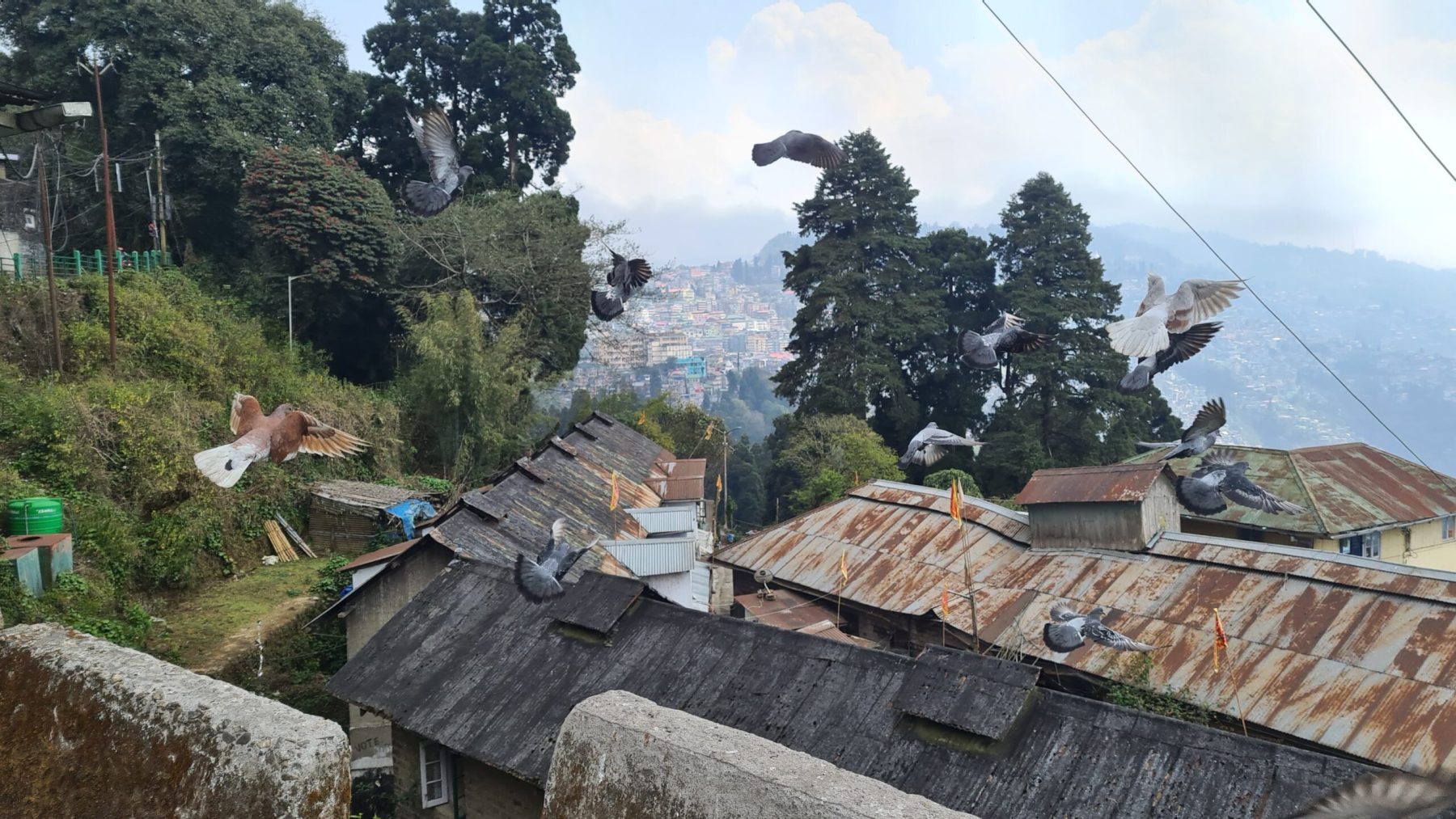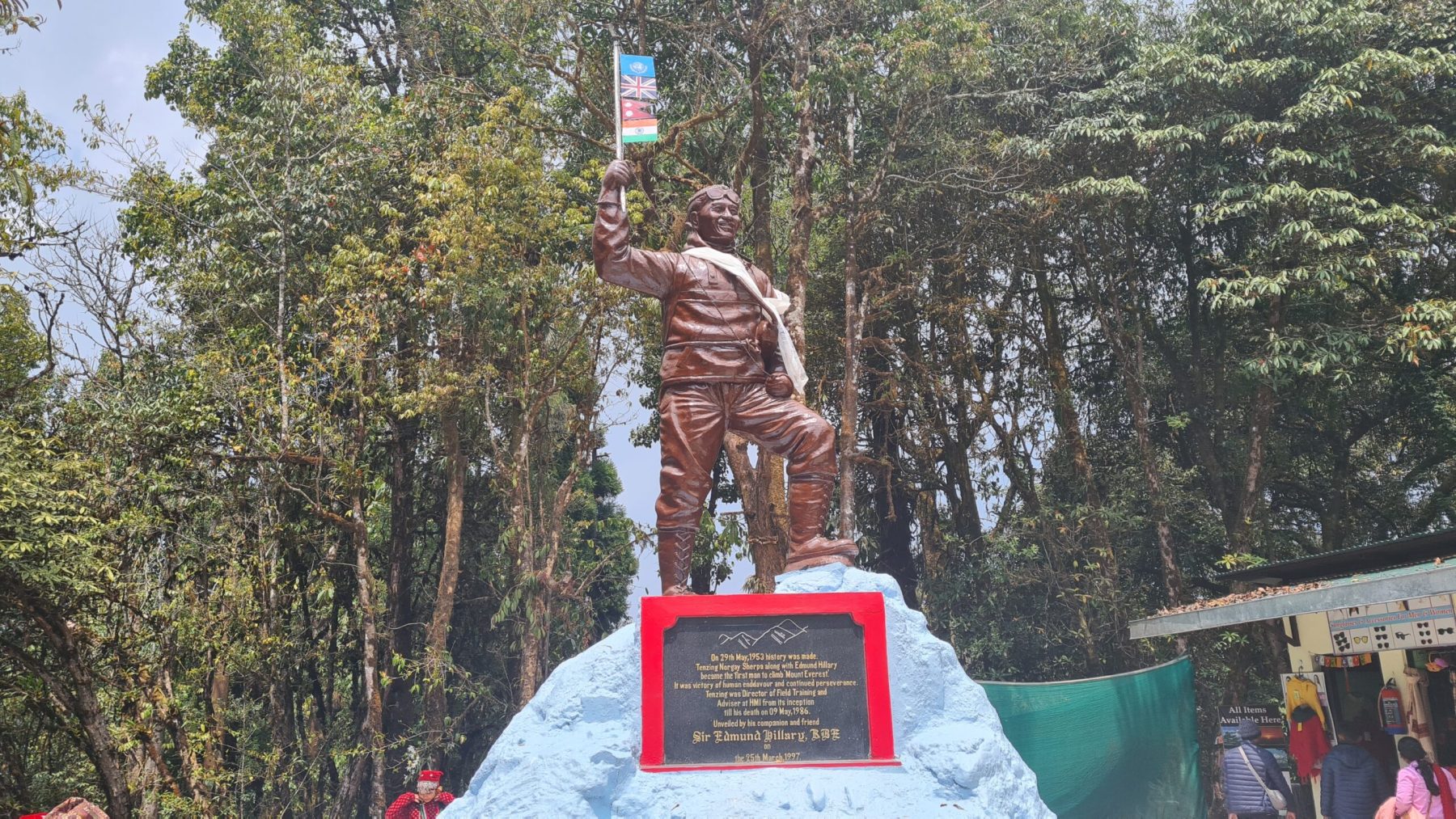As usual this blog is coming to you from the comfort of IRCTC’s hospitality, aka I’m on a train. This time my usual second class wasn’t available, so I’m in third class. Which is much the same – it has AC thank god – but here the beds are in stacks of three rather than two. So while in bed mode you have a little less headroom but assuming I don’t jerk myself awake smashing my head on the top of my coffin I should be okay. During the day the middle bed folds down to form a backrest for the ‘cabin’ in seating configuration.
Leaving Assam, I continue my tea themed tour to the mountaintop city of Darjeeling! Despite sitting at over 2,000m above sea level, it’s actually only considered to be in the measly himalayan foothills. (For reference Ben Nevis’s peak is a mere 1,350m.)
Darjeeling is known as the Queen of the Hill Stations of India. With its relative-ish proximity to Kolkata where the East India Trading Company was initially based, the town provided a mountain top retreat for British holidayers in the 1800’s. While I like to think I’m not too similar to the British who colonised India, in this case I did follow in their footsteps. And boy were they on to something – we’re talking about cool 19° days compared to 30-40°+ at the bottom of the hill – beautiful! The jumpers had to come back out for the evenings, although this probaly a tad dramatic. But maybe not as dramatic as some Indians who donned their puffer jackets and scarfs.
Arriving at the city (by another shared sumo), I began to realise my calves would not be receiving the rest I’d hoped. And this should have been obvious, Darjeeling being a mountainous city and all. Needless to say, getting anywhere meant traversing endless ups and downs. My hostel was pretty central so it wasn’t too bad, and perhaps the active recovery was for the best.
So both the tea connotations and the cool weather pulled me here. However, a little side benefit was the Himalayan Railway, or as it is more affectionately known ‘the toy train’. The railway was originally built to reduce the cost of industry on top of the mountain such as tea farming by increasing the supplies supply, and to carry (exclusively British / upper class) passengers. Talking specifications, a couple of things make these trains special: firstly the gauge used is a tiny 2 feet (60cm) – outrageously small (hence the nickname); the secondly the tracks run alongside and even criss-crosses the main road pretty much all the way up the mountain, through towns and villages, through people’s lives essentially with views into people livings rooms from inside; and thirdly the train runs right up the mountain from Siliguri (the city at the bottom of the hill) up to Ghum (2,258m) then to Darjeeling. Now anyone who knows anything about trains will tell you there is one thing trains really struggle with – and that’s going uphill. Without wanting to get to technical, actually fuck it, its my blog I’ll get technical if I want.
Why trains can’t go uphill – a summary by Hugo.
Entirely un-fact checked.
Trains. Compared to other transport options, trains have a lot going against them: huge initial costs, expensive physical infrastructure, and inflexibility of routes. But for trains: huge passengers numbers per square metre of physical infrastructure, relatively fast, and you can get really drunk on them. But the humble train has one stand out benefit over other transport options – efficiency.
Per amount of fuel trains move far more shit, or people, or shitty people than other options. A good comparison here is to cars where the ‘driving’ difference in efficiency is friction. Cars use grippy rubber tyres against mostly grippy road surfaces. Trains on the other hand use slippy steel on steel. The wheels effectively glide along the tracks with very minimal friction – this is brilliant for trains as it means they go with very little effort, and keep going. Everyone’s happy.
But of course, as with all good superhero stories, the hero’s greatest strength is also their greatest weakness. When it comes to going uphill, friction is really helpful, but as discussed, trains don’t have much. The power of gravity and the lack of friction really hinder a trains ability to ascend gradients. Even with a big run up, a train will simply slide back down the hill once it runs out of momentum.
[end]
The solution to overcome this for the Darjeeling train was fairly simple to be honest. The trains are fairly small in length/weight, and the gradient is physically minimised wherever possible, through the use of loops and zig-zags. Loops fairly obviously are where the train spirals up through shallow loops reducing the gradient as compared to a single curve. The Zig-zags, ascend gradually in straight lines. Where you would expect these straights to be linked by curves they’re not. The tracks meet at tight angles then run together briefly before a deadend, at this point one of the crew hops out and switches the point which the train has just passed across, the train then hits reverse and continues up the mountain backwards. Pretty neat.
I’ve got a few video clips to share with this blog, which is becoming common. I’ll include one of a train engine performing zig-zag. The footage I have has the engine using a zig-zag manoeuvre at a station, but on a slope the concept is the same.
Obviously I had to take a ride on the train. I opted for the steam train ride which still uses the original B-type engines (whatever that means). The engines were very Thomas-esk and the carriages gave very panoramic views across the valleys and indeed into a few people’s houses. I really cannot emphasise enough how close these trains ran to the houses. It must be a right pain living so close, as much like the car drivers of India, the train drivers pull the horn throughout the journey adding to the already noisy train engine (and other pollution). I would say I’ll never complain about the northern line again but I will.
So the cars and the trains share the road, frequently the tracks cross the road following the less steep path at all costs. In these situations the rules of the jungle applied and the train had absolute priority which it exercised at every turn. Despite this priority the train takes 7hrs to ascend the mountain, albeit stopping at serval stations, whereas by road the journey is only 3hrs. Basically trains aren’t brilliant at going up hill.
That’s enough but the trains. Onto the rest of Darjeeling.
I stayed at Hideout backpackers hostel, which was aptly named, as finding it was nearly impossible. But the Hideout’s cafe had stunning views down the mountain – another well earned view. My only complaint of the edgy waffle-cafe / bar was that it allowed smoking inside.
I shared in dorm as one of six, including one enormous spider. Throughout my fairly lengthy stay I made some friends, Moyjank (which I’m definitely spelling wrong) and other Indian tourists were very welcoming roommates. Treating us as guests and sharing their insights into India. Truly generous hosts at all times. If we went for a slice of cake or a beer, it was practically forbidden for any foreigner to pay. Lovely people.
I also met another Philip, this Philip was from Germany, we ended up chatting quite a bit and having a few laughs. On Friday night we went out with a couple others to the local happening spot, who had a five piece rock band playing. I’ll include some clips of the band. The band opened with Superstition by Stevie Wonder. We recognised the tune instantly but couldn’t believe it when the singer started. He was this fairly stocky guy, but with a voice like Michael Jackson hitting all sorts of high notes. He also had a fantastic tee-shirt on. Anyway, we had a lovely time drinking Kingfishers, listening to the band. I ate all of the complimentary bombay mix (which I had refiled three times) and we chatted mostly about board games and life which was lovely. Obviously any good night fueled by beer has the inevitable consequences the next morning. With really shit planning on my part it was the morning I needed an early start to descend the mountain to get my 12:25 train from the bottom. I failed to get my early start. I ended up having to hire a whole jeep to take me down the mountain owing to time constraints. Frankly it was my driver’s aggressive and reckless driving that allowed me to my catch my train with maybe a minute to spare (after a parachute roll out of the jeep).
Food wise, I had a number of recommendations from the other Filip (my friend I travelled Assam with a few days ago – see the Kaziranga/Majuli entry) who is a Dajreeling veteran. He suggested the Hideout hostel actually. Throughout my stay, I worked my way through his recommendations – which came with varying amounts of detail on how to get to these places. The first I searched for and found was a recommendation for good Momos (a type of dumpling and one of my favourites). His advice told me to find the upstairs corridor where the Tibetan Kitchen was located, and then go down the hall until I find the cafe with the picture of the Dalai Lama hanging up. A mini-adventure I loved. He also suggested the Tom and Jerry cafe for a good Thenthuck which he was also right about – and the Tom and Jerry paraphernalia combined with the soft jazz made for a comforting atmosphere. Finally, from around 5pm the main pedestrianised streets filled out with street food vendors – which became my staple evening meal. I think an egg fried noodles (which could be served in a wrap if you wanted more carbs) and a portion of eight momos came to £1.20.
The city itself I’m struggling to describe. It’s set atop this mountain which means you get these stunning views (on clear days). With perfect visibility allegedly you can see Mt Everest – not that I did. The town and its layout felt very old, with tight roads, and endless staircases and shortcuts going places not marked on google maps. I’ve mentioned the steepness which while taxing on the calves, gave you all sorts of views into people’s gardens and their houses. The buildings were a mix, with some impressive single structures (including some with heavy British influences such as the clock tower) but the majority were these charming haphazard residences, shops and cafes. The whole town is tied together through the exposed water piping which looks like it wasn’t planned at all and just expanded as needed. Bundles of tiny pipes following the side of the road, frequently leaking out onto the street, then disappearing through walls or buildings. Despite the chaotic, well, everything; the city was fairly clean and tidy. Throughout the city people had put great effort into cramming as much greenery as possible into the city. Every nook and cranny, of which there were an endless amount, were filled with makeshift planters or just hardy wall-hugging plants. The leaking pipes, providing an automatic watering system to this city wide urban garden. Pretty much anything that could be used to hold a plant was used, including plastic detergent cartons, tyres, bottles – everything. I suppose the alternative to using it for something is getting it back down the mountain, but it gave the city a bohemian beauty.
The main streets were heaving, especially once the street food was out.
I filled the rest of my days with a mix of touristy activities and painting in the cafe. One day I took myself down to the Botanical Garden which set me back a staggering 20p for entry, but being out of the main town was very quiet and a welcome break from the crowds. The gardens had several greenhouses to explore, as well as a huge orchidarium with some stunning unique Orchids.
I also went to the Himalayan Mountaineering Institute / museum (which somewhat unfortunately was located within the zoo) but an interesting few hours covering the attempts to conquer Everest and the equipment etc used. Along with old Edmund Hillary, the first man to reach the peak of Everest was an Indian (/ half Nepalese). A man called Tenzig Norgay who was Edmund’s sherpa, Tenzig was also known as the Tiger of the Snows – which as nicknames go is pretty fucking cool. Sadly the indoor climbing wall was closed, otherwise I would been there showing up all the kids trying to have a good time. Or maybe, more likely they would have shown me up.
While the HMI was interesting, my preferred museum was the Tibetan Museum. A tiny museum detailing the modern history of the Tibet, including the Dalai Lama and Chinese rule over the region – all very interesting. The museum interior was stunning itself, brightly coloured decorative ceiling/wall features (I know these have a name – someone help me out). But the model of the Potala Palace alone was enough to win me over – something I now very much want to see.
The final bit I’ll mention is the morning I spent at the Happy Valley tea plantation and factory. The plantation is one of the oldest and smallest in Darjeeling who supply Harrods with their darjeeling tea (allegedly). Also being walking distance from the centre of town I was worried it would be overrun, so I made an effort and got there for opening at 9am. Well okay I managed 9.15.I paid my 100 Rs for the tour and tea tasting. To my surprise I was the only person on the tour so got a personal guide to the tea making process. Also by complete accident I timed my trip to Darjeeling perfectly with my visit coinciding with the first harvest of the year – which produces the most premium tea. I’ll brief you on the tea making process in a mo, sadly photography wasn’t allowed so no pictures. But at the end of my tour, the guide and I joined the tea factory manager comparing yesterday’s product to that mornings. So by sheer luck I was trying the freshest possible ‘first flush’ tea in Darjeeling. I’m not gonna lie it was likely wasted on me, they both tasted broadly the same. Nice obviously and maybe a touch more fruity/floral than other darjeeling tea I’ve had, but not earth shattering. All in all the experience was lovely. Oh and the experts insisted on slurping the tea (presumably for aeration).
Okay so I will leave you with the tea process before this gets any longer. Tea is harvested, by hand, from mid-March to November. Within this window there are four picking seasons: First Flush, Second Flush (these two being premium harvests giving the most flavourful tea), Monsoon Flush and Autumn Flush. The Monsoon flush is the weakest and is mixed with the Autumn flush to create ‘regular’ darjeeling tea.
The process starts with picking / plucking. Only the new baby leaves are harvested, all by hand.
The next step is ‘withering’ where the tea is spread out of large conveyor belts and blasted with hot and cold air. This process reduces the moisture content of the leaves, increasing the concentration of the tea. But also softens the leaves so they are not damaged in the next few stages.
The next step is ‘rolling’ where the leaves are well rolled under pressure. This releases the enzymes in the leaves.
The next step is ‘oxidation’, a fancy term for leaving the tea out for a while. The tea is once again spread out and fresh air is allowed to pass over the tea. This process allows the enzymes to do their thing and releases caffeine. If you’re making green tea you wouldn’t do this step as you don’t want the caffeine. For first flush tea this only takes 20-25 minutes however for the inferior monsoon or autumn flushes this can take 2 to 2.5hrs.
Next, once the tea has released all of its teay goodness, it’s time to lock that in. The next step is ‘drying.’ Again this is slightly different depending on the flush. First flush is dried at 107°c whereas other teas are dried at closer to 121°c. The drying is done in a big conveyor oven. One guy shovels the tea in the top, the machine spreads it out and it works its way through the oven falling from conveyor to conveyor until it slides out the bottom of the oven where another guy shovels into crates for the next stage.
Moving towards the end of the process now, the tea is sorted. Where the leaves are separated by size, from full leaves to crushed leaves. The machine is essentially a big vibrating coin sorter but for tea. This process is known as ‘grading.’
Then finally the tea is cleaned and packaged. These are mostly done by machine, but of course to add to the premiumness, for the first two flushes are done by hand.
The next step is to add boiling water, wait five mins and slurp it up.
So I’ll leave you to make yourselves a nice cuppa. Darjeeling or otherwise. And will see you in the next one.






This part of your journey sounds like my sort of place. Tea, gardens and stunning views, what more could you ask! Not so sure about the spider though. I don’t usually mind them but that one looked huge. Looking forward to your next instalment. Travel safe. Love as always.
Ahaha thanks mum and yeah. As a Polish friend later remarked on Assam and Darjeeling – “what a trip for an Englishman!” Love you too!
Hugo, I feel like you are really getting into a rhythm and style with your blogs and I really like them. Amusing, informative and engaging. Great stuff. I like the look of Darjeeling, and am beginning to want to head that way myself, although I think I’d use hotels not hostels; not sure about mums willingness though. I love the detail and the photos. Keep yourself safe and enjoy walking to Tibet. Xxx
Hi Hugo, loved the video, and you are right the little steam train was like Thomas. Your patience with the “clown” was laudable. I think I may have given him a permanent middle parting by smashing the bottom edge of my phone into his skull. And he certainly deserved a good amount of time wearing the T-shirt of the singer of the band.
🙂
Ahaha thanks Dad, I was hoping the train would get him and I could keep my hands clean! Yeah I think you guys would love Darjeeling, although maybe a touch busy and not a beach in sight! Thanks xx